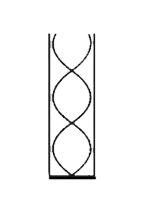In closed organ pipe at one end-

A-T,B-P,C-P,D-T
A-S,B-P,C-P,D-(Q,T)
A-S,B_Q,C-R,D-Q
A-R,B_Q,C-S,D-(Q,T)
The correct Answer is:B
For (A) in column (I):
third overtone frequency =7f0
∴x=7
for (B) in column (I):
Second overtone =5f0
∴No of nodes=3
For (C) in column (I)
Second overtone=5f0
No of antinode=3
For (D) in column-I
In closed organ pipe even harmonics does not exist.
So, n=2,4,6, . ..


Similar Questions
If the fundamental frequency of a closed of pipe is equal to the first overtone of an open organ pipe then the ratio of lengths of closed organ pipe to open organ pipe is
View SolutionCompare the length of a closed organ pipe and an open organ pipe, if the second overtone of the open pipe is unison with the second overtone of the closed organ pipe.
View Solution
Knowledge Check
- Question 1 - Select One
Assertion: An open organ pipe of certain length has the same fundamental frequency as closed organ pipe of half the length.
Reason : In case of an open organ organ pipe, at both the ends antinodes are formed while in case of closed organ pipe, at one end antinode and at the other end node is formed.AAssertion is True, Reason is True, Reason is a correct explanation for AssertionBAssertion is True, Reason is True, Reason is not a correct explanation for AssertionCAssertion is True, Reason is FalseDAssertion is False but, Reason is True. - Question 2 - Select One
The fundamental frequency of a closed organ pipe of length 20cm is equal to the second overtone of an organ pipe open at both the ends. The length of organ pipe open at both the ends is
A140 cmB80 cmC100 cmD120 cm - Question 3 - Select One
The fundamental frequency of a closed organ pipe of length 20cm is equal to the second overtone of an organ pipe open at both the ends. The length of organ pipe open at both the ends is
A80cmB100cmC120cmD140cm
Compare the length of a closed organ pipe and an open organ pipe, if the second overtone of the open pipe is unison with the second overtone of the closed organ pipe.
View SolutionA closed organ pipe (closed at one end) is excited to support the third overtone. It is found that air in the pipe has
View SolutionOrgan pipes are musical instruments which are used for producing musical sound by blowing air into the pipe. Organ pipes are of two types: closed organ pipes are closed at one end and open at the other. Open organ pipes are open at both ends.
The study shows that the overall musical sound produced by an open organ piipe is richer than the musical sound produced by a closed organ pipe.
Read the above passage and answer the following questions:
(i) Why the overall musical sound produced by an open organ pipe is richer than the musical sound produced by a closed organ pipe ?
(ii) What does this study imply in day to day life ?View SolutionA closed organ pipe of length L is in resonance with a tuning fork. If a hole is made in the pipe at a distance L4 from closed - end, it will be in resonance again, when:
View SolutionA closed organ pipe of length 28 cm closed at one end is found to be at resonance when a tuning fork of frequency 850Hz is sounded near the open end. If velocity of sound in air is 340 m/s, then the
View Solution
